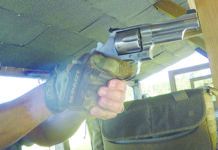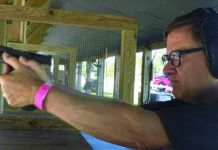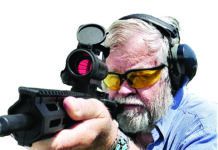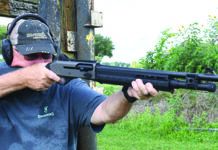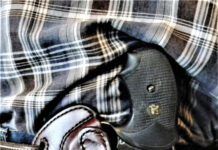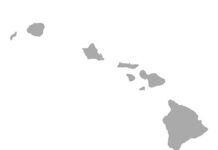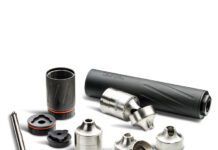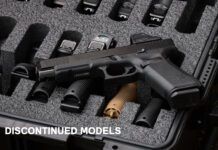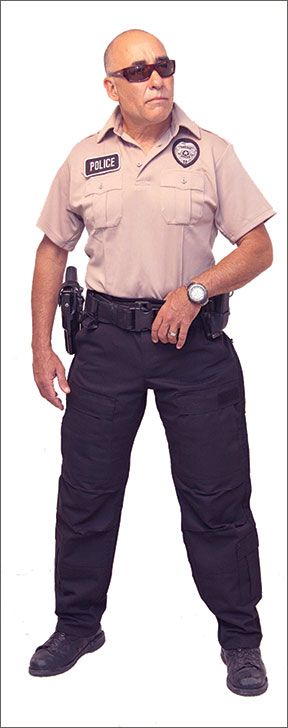
Weapons concealment is all about blending in. Thats where pants by American Tactical Apparel (ATA) with an integrated holster and magazine pouch come in. Rather than requiring a secondary garment such as a jacket, vest, or untucked shirt to cover a holstered weapon, the wearer is free to display a normally belted midline with tucked shirt. This is a key point in eliminating a common visual clue that youre carrying a handgun.
American Tactical Apparel sells through USAammo.com and currently offers BDU-style pants referred to as Battle Khakis in both a poly-cotton blend and denim. The Battle Khakis are available in black, navy blue and olive green as well as the traditional khaki tan. The denim pants are indigo blue jeans. Pricing is $100 for the full-length poly-cotton pants and $149 for the blue jeans. But according to an ATA representative, their goal is further development of the denim pants and a price point of $100. Poly-cotton BDU or trekker-style shorts ($80) are also available, but only in tan. Additional holsters and magazine pouches are sold separately for $50. All ATA garments are made in USA. There is also a tailoring service to reconfigure customer-supplied pants for a fee of $40. Our test pants were a pair of tan Battle Khakis, a second pair in black, and the latest addition to the ATA catalog, a pair of $80 dress pants.
Weapons and accessory retention is accomplished by a neoprene holster system that wraps around the wearers leg, covering the middle portion of the thigh and connecting to the inside of the pants just below the belt line. The holster system may be worn on either side, and the same holster or magazine pouch may be used on multiple pairs of pants. Access to the weapon or spare magazine was by pulling down a zipper that runs along the outer seam along either side.
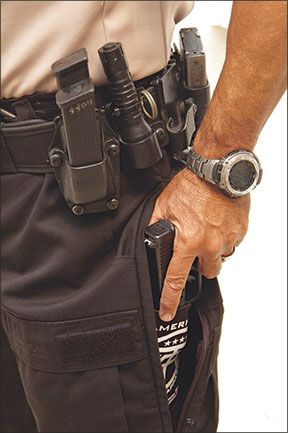
The Battle Khakis offered double stitching and bar tacks at stress points. Seams at the crotch, knee, waistline and shins were designed for enhanced mobility. The belt loops were wide and spaced far apart, so theres a lot of area to allow an inner and outer belt system to make a solid connection. The waistband was reinforced and padded. The front pockets offered a clip ledge. This is a horizontal seam at the bottom of the pocket mouth measuring about 1.3 inches long to accommodate the clip of a tactical folding knife. Brian Hoffner, designer and chief consultant to American Tactical Apparel, added this feature so the clip can take a solid hold but offer a snag-free draw. Hoffner also added a zippered coin pocket to discourage the wearer from dumping coins in the same pocket as a folding knife where they can work their way into the handle and jam the knife.
The total amount of pockets found on the Battle Khakis numbered 15. This would be great on a mission or hunting in the field, but for true concealment wed say they were obvious clues that you are carrying a concealed weapon. Not to mention the ATA logo and a Velcro patch for adding ID. The denims appear to be a lot more discrete, with only the coin pocket and a very low profile vertical slit pocket located at the calf. But for the uniformed officer, the black color pants were a good choice because they provided concealment for a backup weapon without requiring an additional cover garment. In the meantime, the new dress pants were, in our view, the best way to blend into society and still carry a gun.
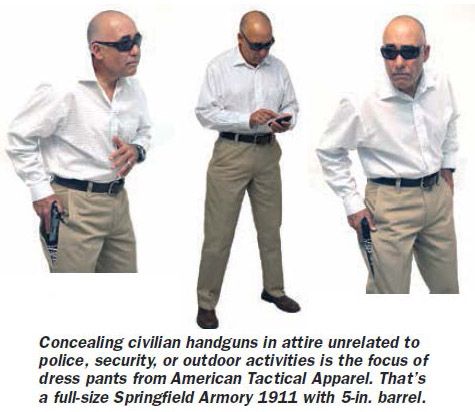
After spending a couple of weeks wearing the Battle Khakis, here is what we found. First, the pants didnt wrinkle or stain. After three days we felt like we should wash them whether they needed it or not. They were pajama comfortable, and the zippers worked easily. We liked the feel of the pockets inside and out. The tricky part was getting the holster the way we wanted it. Actually, we began by wrapping it too tightly, which seemed like the natural way to apply it. We suspect this is a common mistake. Ultimately, we opted to let the hanger do the work and allow for the holster to ride up and down a little, so we could sit and move about comfortably. The wrap was fastened using Velcro, with the softer Velcro surface facing outward. The rough or looped component faces the leg, but it was narrower and shielded from contacting the skin by the soft side of the Velcro. That is, unless your thigh is so large in circumference that the looped Velcro is exposed. Some of our staff felt no discomfort at all. Others were sensitive enough to be bothered slightly by the stitching itself that connected the Velcro to the neoprene. But the neoprene surface breathed well, and no one had any complaints about sweating or chafing. For my part, I chose to wear the holster wrapped somewhat loosely and applied a layer of split cowhide between my skin and the area where the Velcro was. American Tactical Apparel is now developing matching cool comfort underwear to make the outfit more comfortable and even more efficient.
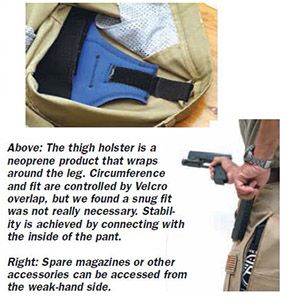
Holstering was a two-handed affair, and in most cases we could get the lip of the neoprene pouch to cover the rear of the slide. Naturally, larger guns were more difficult to conceal but we were surprised how much gun we could hide. We found the holster was able to hold the gun securely and make it available even from a seated position.
Our Team Said: Concealment is a bit of an art. Getting away from the traditional holster takes special tools to make it happen. We think the modular design of American Tactical Apparel offers options well worth consideration by anyone who seeks to exercise their right to carry a concealed handgun.
Written and photographed by Roger Eckstine, using evaluations from Gun Tests team testers. GT





